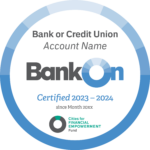Bank Marketing Strategy
In today’s world, banking services have become an integral part of our lives. However, there are still millions of individuals who remain unbanked or underbanked. According to the FDIC’s recent Survey of Household Use of Banking and Financial Services, about a quarter (23.3 percent) of U.S. households with annual incomes of less than $15,000 were unbanked, as were 10.4 percent of households earning between $15,000 and $30,000.
Local banks have a unique opportunity to help bridge the gap and provide valuable support. By serving the unbanked and underbanked, community banks and credit unions can help those in and around their community gain access to safe, secure, and affordable banking services, which can improve their financial stability and well-being.
What does it mean to be unbanked or underbanked?
Both the unbanked and the underbanked use alternative financial services. A bank account is the primary distinction between these two groups.
To be unbanked means you don’t have a checking or savings account with a traditional financial institution. People who are unbanked may rely on alternative financial services such as check cashing, money orders, and payday loans.
On the other hand, to be underbanked means you have a bank account but still use alternative financial services to meet some needs.
Why are people unbanked or underbanked?
There are several reasons why someone might be unbanked or underbanked. The most common reasons include:
- Lack of money: Unemployed or don’t have enough income to meet the minimum balance requirements at financial institutions.
- Lack of credentials: Don’t have all the necessary information, such as a social security number, to open a bank account.
- Distrust of financial institutions: Whether because of prior bad experiences or beliefs held by their friends and family, they choose not to use a traditional bank.
- Poor financial self-image: Feel that they lack the skills or knowledge to manage their finances through traditional banking services.
- Language or literacy barriers: English is not their first language or a low level of literacy makes it hard to access traditional banking services.
- Lack of local access to convenient, affordable banking services: Some people may live in areas where there are few local options.
- Need or preference for alternative financial services: Some people may prefer to use alternative financial services, such as check cashing or payday loans, instead of traditional banking services.
- Inability to afford bank fees: Some people may not be able to afford the fees that can come with maintaining a bank account, such as overdraft fees, ATM fees, and maintenance fees.
- Privacy concerns: Some people may have concerns about the privacy of their financial information and may choose to use alternative financial services instead of traditional banking services.

10 Strategies For Serving the Unbanked and Underbanked
Despite the challenges associated with this segment of the market, there are steps financial institutions can take to reach out to and better serve the unbanked and underbanked in your community.
- Language Access and Cultural Sensitivity: Cater to diverse communities and provide multilingual support to serve customers with limited English proficiency. Ensure cultural sensitivity by training your staff to understand and address the unique needs and challenges of different communities.
 Bank Account Opening Initiatives: Simplify the process of opening a new bank account to make it easier for unbanked and underbanked individuals to establish a new banking relationship.
Bank Account Opening Initiatives: Simplify the process of opening a new bank account to make it easier for unbanked and underbanked individuals to establish a new banking relationship.- Low-Cost or No-Fee Accounts: Offer low-cost or no-fee bank accounts with low or no minimum balance requirement and reduced or waived fees to make banking more accessible. Consider joining over 400 banks and credit unions that offer a Bank On certified account, there’s no cost for the certification but there are numerous benefits.
- Financial Education Programs: Organize financial literacy programs and workshops to educate unbanked and underbanked individuals about basic financial concepts, budgeting, savings, credit, and responsible banking practices.
- Credit-Building Programs: Offer credit-building programs that help individuals establish or improve their credit scores. These programs could include secured credit cards, credit-builder loans, or credit counseling services to assist the unbanked and underbanked in building a positive credit history.
- Small-Dollar Loans and Microfinance: Provide small-dollar loans and microfinance options to unbanked and underbanked individuals who may not qualify for traditional loans. These loans help them meet short-term financial needs and build creditworthiness.
- Collaboration with Community Organizations: Collaborate with community-based organizations, nonprofits, and local government agencies to identify and reach out to unbanked and underbanked populations. By partnering with these organizations, banks can provide financial services and resources directly to those in need.
- Collaboration with Local Businesses: Host a job fair for the local community to match job seekers with local businesses.
- Mobile Banking and Digital Tools: Continually improve technologies that enable the unbanked and underbanked to conduct transactions, pay bills, and save money without the need for traditional brick-and-mortar branches.
- Mobile Banking Units and Pop-up Branches: Some local banks deploy mobile banking units or establish pop-up branches in underserved areas, bringing banking services directly to the communities that lack easy access to traditional bank branches.
Benefits of Serving the Unbanked and Underbanked
Increasing your FI’s reach among this population doesn’t just help you attract new customers. It also benefits the local communities you serve and can help boost your brand image.
- Improve access to safe, secure, and affordable banking services: Providing trustworthy, personalized and convenient experiences can help improve customer satisfaction and increase the likelihood that customers will continue to do business with the bank.
- Foster financial stability and well-being: Offerings can help individuals build savings, manage their finances, and achieve their financial goals.
- Build customer loyalty, engagement, and trust: Providing personalized and convenient experiences can help improve customer satisfaction and increase the likelihood that customers will continue to do business with the bank.
- Tap into a new customer resource: By providing access to basic financial services, banks can attract new customers and generate additional revenue.
Put these strategies into action!
Serving the unbanked and underbanked community is an important endeavor for local banks. Your bank or credit union can make a positive impact on local communities while also growing your business. Need help putting these strategies into action? BankBound provides an extensive team of marketers, with years of experience in the financial industry, to support your efforts. We can assist with a targeted approach to getting the word out about your products and services, or partner as an extension of your team to help with the heavy lifting. Contact us today to learn more about BankBound and how we can support your marketing goals.


